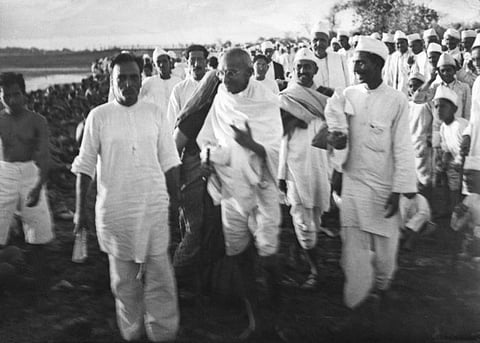
- Home
- Live Blog
- Breaking News
- Top Headlines
- Cities
- NE News
- Sentinel Media
- Sports
- Education
- Jobs

Satish Kumar Sarma
(The writer is former Head of the Department of Economics, Biswanath College, Biswanath Chariali)
Mahatma Gandhi is a national inspiration and inevitable symbol for all humanitarian efforts in favour of peace and non-violence across the world. It is deeply significant that the practice of non-violence has acquired global resonance in our times. The Gandhi-led non-violent independence movement played a critical role both in galvanizing grassroots resistance to British rule and in helping to gain independence. But the decisive factor was the protracted World War II, which reduced to ruins large swaths of Europe and Asia, especially the imperial powers. The war between the Allied and Axis powers killed 80 million, or 4% of the global population.
Despite the Allied victory, a devastated Britain was in no position to hold on to its colonies, including ‘crown jewel’ India. Even colonies where there was no grassroots resistance to colonial rule won independence in the post-World War II period.
The British had dominated India through a Machiavellian divide-and-rule strategy. Their exit came only after they had reduced one of the world’s wealthiest economies to one of its poorest. Indeed, they left after they had looted to their heart’s content, siphoning out at least £9.2 trillion (or $44.6 trillion) up to 1938, according to economist Utsa Patnaik’s recent estimate.
Had the post-1947 India been proactive and forward-looking in securing its frontiers, it could have averted both the Kashmir and Himalayan border problems. China was in deep turmoil until October 1949, and India had ample time and space to assert control over the Himalayan borders. But India’s pernicious founding myth gave rise to a pacifist country that believed it could get peace merely by seeking peace, instead of building the capability to defend peace.
Here’s the paradox: Countless numbers of Indians died due to British colonial excesses. Just in the manmade Bengal famine of 1942-45, six to seven million starved to death (a toll far greater than the ‘Holocaust’) due to the British war policy of diverting resources away from India. Britain sent Indian soldiers in large numbers to fight its dirty wars elsewhere, including the two world wars, and many died while serving as cannon fodder. Indeed, the present Indian republic was born in blood: As many as a million civilians died in senseless violence and millions more were uprooted in the British-contrived partition.
Yet the myth of India uniquely charting and securing its independence through non-violence was propagated by the inheritors of the Raj, the British-trained ‘brown sahibs’. No objective discourse was encouraged post-1947 on the multiple factors - internal and external - that aided India’s independence.
The hope of Indian independence was first kindled by Japan’s victory in the 1904-05 war with Russia - the first time an Asian nation comprehensively defeated a European rival. However, it was the world war that Adolf Hitler unleashed - with imperial Japan undertaking military expeditions in the name of freeing Asia from white colonial rule - that acted as the catalyst. An emboldened Gandhi served a ‘Quit India’ notice on the British in 1942.
While the Subhas Chandra Bose-led Indian National Army (INA) could not mount a formidable threat to a British colonial military overflowing with Indian recruits, the Bombay mutiny and other sepoy revolts of 1946 triggered by INA prisoners’ trials undermined Britain’s confidence in sustaining the Raj, hastening its exit. Yet, independent India treated INA soldiers shabbily, with many abandoned into penury.
Against this background, the rehabilitation of Bose and the INA has long been overdue. Prime Minister Narendra Modi has done well to initiate the process, however low-key, to give Bose and the INA their due, including renaming one Andaman island after Bose and two other Andaman Islands to honour INA’s sacrifices. Modi even wore the INA cap to address a public meeting in Andaman on the 75th anniversary of Bose’s hoisting of the tricolour there.
Recognising unsung heroes is an essential step towards rebalancing the historical narrative. A rules-based international order premised on non-violence remains a worthy aspirational goal. But Indian romancing of non-violence as an effective political instrument crimped national security policy since independence. The country hewed to pacifism (with Prime Minister Jawaharlal Nehru publicly bewailing in 1962 that China had ‘returned evil for good’) and frowned on materialism (even after China surpassed India’s GDP in 1984-85).
The burden of its quixotic national philosophy has imposed enduring costs, including an absence of a strategic culture, as the late American analyst George Tanham famously pointed out. Lack of a culture to pursue a clear strategic vision and policy hobbles India’s ambition to be a great power.